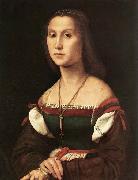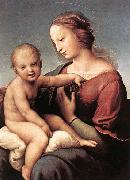
|
Artists
Index
|
||
|
RAFFAELLO Sanzio
|
||
|
The Adoration of the Magi new21/RAFFAELLO Sanzio-577356.jpg ID de tableau:: 63815 |
1502-03 Oil on canvas, 27 x 150 cm Pinacoteca, Vatican Extant drawings demonstrate the tremendous amount of thought which Raphael put into the realization of the Oddi Altarpiece and some details, notably the highly individual faces of the Apostles and the serene landscape in the background, are quite masterful. But the most meaningful passages are found in the predella scenes: the vast space which opens out beneath the colonnades of the Annunciation; the highly animated Adoration of the Magi; and the free quality of the atmosphere in the Presentation in the Temple, which foreshadows the extraordinary spatial intuition of some of the artist's future Vatican compositions.Artist:RAFFAELLO Sanzio Title: The Adoration of the Magi (Oddi altar) Painted in 1501-1550 , Italian - - painting : religious | |
| |
|
|
|
|
||
|
Madonna and Child Enthroned with Saints new21/RAFFAELLO Sanzio-263256.jpg ID de tableau:: 63816 |
Madonna and Child Enthroned with Saints 1504-05 Tempera and gold on wood, 172,4 x 172,4 cm (main panel) Metropolitan Museum of Art, New York This is the main panel and lunette from a relatively early work by Raphael, also known as the Colonna Altarpiece, painted for the convent of Sant'Antonio da Padova at Perugia. He began the work when he was barely 20 years old, just before he left for Florence in 1504, and he completed it the following year after he returned to Perugia. The influence of his teacher Perugino can be seen in the conservative composition. Nevertheless, Raphael has infused into the stiffly posed group a breadth and dignity that reflects his knowledge of the work of Fra Bartolommeo in Florence. Particularly beautiful is the way the figures fill the curved shape of the lunette. Flanking the Madonna and Child with the infant Saint John the Baptist are Saints Peter, Catherine, Cecilia(?), and Paul.Artist:RAFFAELLO Sanzio Title: Madonna and Child Enthroned with Saints Painted in 1501-1550 , Italian - - painting : religious | |
| |
|
|
|
|
||
|
Portrait of a Woman new21/RAFFAELLO Sanzio-977337.jpg ID de tableau:: 63818 |
1507 Oil on wood, 64 x 48 cm Galleria Nazionale, Urbino The female portrait known as The Mute Woman represents a return to the influence of Leonardo. It certainly comes from the Florentine environment, for it was given in trust to the National Gallery of the Marches by the Uffizi, where it had been stored for several hundred years. It was attributed to Raphael only recently. Leonardo inspires mainly the pose of the figure (whose characteristically crossed hands constitute a very clear reference to the Mona Lisa). The neatness of the large areas of colour which emerge in lighter tones from the near-black background, and the analytical treatment of the details of the woman's clothing are characteristic of Raphael. The dispersive effect of this attention to detail is fully compensated by the tones of colour - used here in a fairly limited range - which unify the composition as a whole.Artist:RAFFAELLO Sanzio Title: Portrait of a Woman (La Muta) Painted in 1501-1550 , Italian - - painting : portrait | |
| |
|
|
|
|
||
|
Theological Virtues new21/RAFFAELLO Sanzio-628265.jpg ID de tableau:: 63819 |
1507 Oil on wood, 16 x 44 cm (each) Pinacoteca, Vatican The three compositions (Faith, Hope and Charity), executed in a delicate monochrome, formed the predella belonging to the Entombment now in the Borghese Gallery, Rome. Both the main panel and the predella were carried from Perugia to Rome by Pope Paul V. They were replaced by copies in 1608.Artist:RAFFAELLO Sanzio Title: Theological Virtues Painted in 1501-1550 , Italian - - painting : mythological | |
| |
|
|
|
|
||
|
Madonna and Child new21/RAFFAELLO Sanzio-966688.jpg ID de tableau:: 63820 |
1508 Oil on wood, 81 x 57 cm National Gallery of Art, Washington The dominance of the lyrical and graceful aspect of this painting (known also as The Niccolini-Cowper Madonna) over the religious content mark it as belonging to Raphael's Florentine period, 1505-08. In fact this panel, signed and dated 1508, was executed near the end of Raphael's stay in Florence. The date 1508 and the artist's monogram "RV" have been worked into the embroidery of the Virgin's robe. The title derives from the names of two former owners. The full, well-formed figures reveal an early influence of Michelangelo, while the soft modeling and the use of chiaroscuro reveal the influence of Leonardo. Fra Bartolomeo's influence is particularly clear. The composition is extremely simple and essential; the gesture of the Child, who stretches his hand toward the Virgin while turning his attention toward the spectator, and the gesture with which the Virgin holds the hand to her breast, provide the only signs of life. The sentiment of anxious motherhood which, enriched by greater awareness, will be fully expressed in the Tempi Madonna, now in the Alte Pinakothek of Munich, appears here for the first time.Artist:RAFFAELLO Sanzio Title: Madonna and Child (The Large Cowper Madonna) Painted in 1501-1550 , Italian - - painting : religious | |
| |
|
|
|
|
||
| Artiste précédent Artiste prochain | ||
|
Also Buy::. For Following Paintings / Artists / Products, Please Use Our Search Online: |










